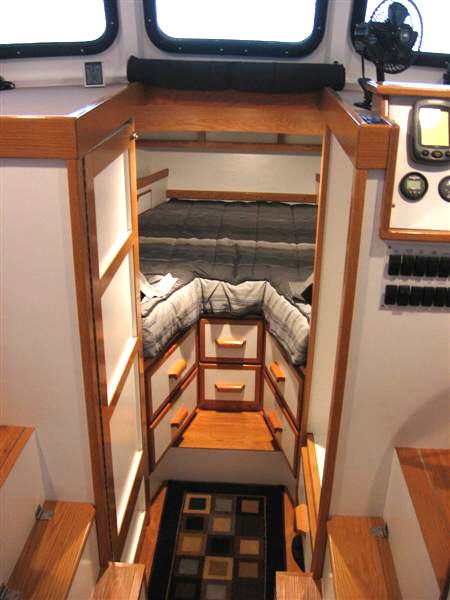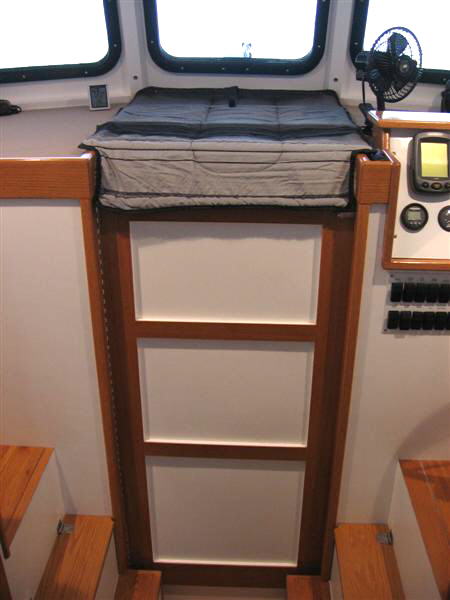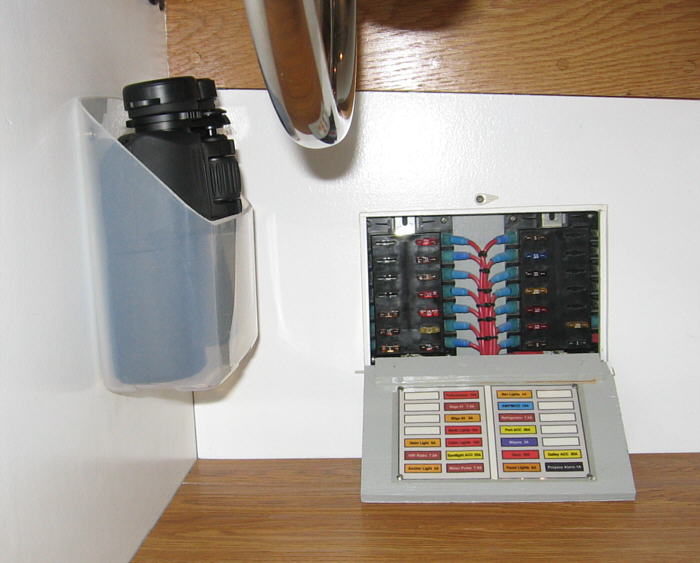|
The Head/Berth Door
Early in the saloon planning stages I decided I wanted to try to make the head door serve a dual purpose. But it meant I needed to decide on some very close dimensions and build to match so the door would close cleanly into two separate frames. The idea was when closed it would hide the head from view (head can not be used with it in this posistion)
When opened it will latch to the forward bulkhead and become a privacy divider for the head and berth area. I was able to make it work out fairly well. I did struggled with a method to cover the opening at the top. I wanted a solid surface but couldn't design a simple method of it opening and folding without it being in the way. I finally decided on a uncomplicated roll down cloth cover. It was made from the cutout of the berth bedspread and I added a couple internal strips of light aluminum bars to support it. When needed it is just rolled out and flips down over the front. This provides total isolation of the head and berth. When not in use it rolls up against the windshield frame (as seen in the first two photos above). A little crude but it works well.
The Helm Many boats of this type have the helm station designed to be able to stand at the wheel. I assume the purpose of this is for rough weather and allowing your legs to absorb the shock. For me this seemed to present several problems plus does not match my boating style. First, since my main theater of operation will be rivers the rough water problem is much less pervasive Second, in photos I collected of many of these vessels, if room allows there is usually a stool of some type brought in for use. It seems they, like me, tend to think standing at the wheel for hours on end is too much like work. Plus, I would think a loose stool sliding around during rough weather or for that rogue wake could too be a problem. The standard arrangement often has a seat or settee behind the helm, which is nice but the wheel is not usually within reach. Some have a drop down seat that tends to try to serve the dual purpose.
But I had a problem with all of these options. For one, I am not going to be standing at the wheel - just not what I want to do. If it is so rough I can't endure it sitting I will be off the main channel and in a cove somewhere. I know, I know - the naysayers will declare there is always that chance but in 27,000 miles of river travel in Therapy I have yet to find myself in a position where I could not find shelter so I will take the odds on this one.
Another reason I did not want standing room is space is at a premium in a boat this size. For balance reasons I wanted the house battery banks forward where they would be closer to the Center of Buoyancy. Also, the banks needed to be located so they were easy to service. I was going to use four flooded golf cart batteries with a large amperage charger so water would need to be added on a regular basis. As it worked out, the ideal space was below my feet (and the Admiral's) when seated. Here I could build an airtight box and vent it directly through the hull allowing the hydrogen gas to escape harmlessly. Two batteries could be placed on each side helping to keep everything balanced and prevent a list. If standing space was provided I would lose this area for storage plus additional space would be required to accommodate both the seated and standing room. For these reasons I opted for a seated position only.
In the above photo the Edson PowerKnob can be seen mounted to the wheel. This has proven to be an excellent option. Handling the boat at the dock is much easier using the spinner to rapidly pivot the engine. I tried a less expensive automotive unit first but it had a problem trying to attach to the somewhat oval profile of the wheel's outer ring. The Edson mounted easily and securely. It was somewhat expensive but is a quality unit and to me worth the cost. Had I earlier realized the value of the spinner I would have probably bought a wheel with one built in.
The contoured helm seat pan (laminated from three layers of 1/8" plywood) flips up and provides a small storage area directly below it . I envisioned this for chart books but right now have the log and a folder with all the data sheets for the equipment installed. Directly below it is a thin pullout shelf for the "in use" chart book but also can serve dual duty as a place to set a plate for having lunch while underway. The required fold down cup holder is also installed and ready for use at a moments notice.
Below the sliding shelf is a drawer and below it is a cabinet for general storage but also serves to house various system equipment. Mounted inside is the fresh water pump, the windlass remote control box, 1500 watt inverter, a 40 amp Xantrex battery charger and a Blue Seas automatic charging relay. It also provides access to the inlet and outlet fittings on the two 40-gallon plastic water tanks as well as three plastic conduit raceways that allow wiring to cross to the port side of the hull. The small step to ease entry to the helm seat holds the valves for the fresh water tanks and a little additional storage.
Located at the the pilots feet along the hull side is the DC fuse panel with a layout diagram. Also, I mounted a holder for the binoculars on the bulkhead. I wanted them handy but was surprised by the cost of factory made units to do this. I found a $3.00 plastic water pitcher at WalMart that was the right size and cut it off at an angle with my bandsaw. On the opposite side is the Admiral's seat and the pan has a similar but smaller storage area below.
Below that is the AM/FM/CD radio. On each side of the radio is a LED voltage meter, which monitors the charge level of the two house battery banks. Below those is a sliding storage area I refer to as the pantry. It is designed to handle food items of varying sizes and keep them in place
|




